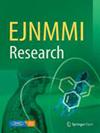通过[18F]FDG PET/CT 鉴别胸腺囊肿和低风险胸腺瘤
IF 3.1
3区 医学
Q1 RADIOLOGY, NUCLEAR MEDICINE & MEDICAL IMAGING
引用次数: 0
摘要
胸腺囊肿是一种罕见的良性疾病,需要与低危胸腺瘤相鉴别。[18F]氟脱氧葡萄糖(FDG)正电子发射断层扫描(PET)/计算机断层扫描(CT)是一种用于鉴别诊断胸腺上皮肿瘤的无创成像技术,但其对胸腺囊肿的作用仍不明确。我们的研究评估了[18F]FDG PET/CT 的肉眼观察结果和定量参数在区分胸腺囊肿和低危胸腺瘤方面的作用。回顾性分析了因胸腺肿块接受术前[18F]FDG PET/CT和胸腺切除术的患者。评估的[18F]FDG PET/CT 视觉结果包括 PET 视觉分级、PET 中央代谢缺陷和 CT 形态。评估的定量[18F]FDG PET/CT 参数包括 PET 最大标准化摄取值(SUVmax)、CT 直径(厘米)和以 Hounsfield 单位(HU)表示的 CT 衰减。采用皮尔逊卡方检验、曼-惠特尼U检验和接收器操作特征曲线(ROC)分析评估了胸腺囊肿与低危胸腺瘤的鉴别结果和参数。最终纳入了 70 例患者(18 例胸腺囊肿和 52 例低危胸腺瘤)。PET视觉分级(P<0.001)和PET中心代谢缺陷(P<0.001)在胸腺囊肿和低危胸腺瘤之间显示出显著差异,但CT形状没有显示出显著差异。在定量参数中,PET SUVmax(P < 0.001)、CT 直径(P < 0.001)和 CT HU(P = 0.004)显示出显著差异。在 ROC 分析中,PET SUVmax 的曲线下面积(AUC)最高,为 0.996(P < 0.001),截断值等于或小于 2.1 的敏感性为 100.0%,特异性为 94.2%。PET SUVmax的AUC明显大于CT直径(P = 0.009)和CT HU(P = 0.004)。在所研究的[18F]FDG PET/CT参数中,低FDG摄取(SUVmax ≤ 2.1,等于或小于纵隔)是胸腺囊肿的有力诊断标志。PET 可视分级和中心代谢缺陷是很容易获得的发现。本文章由计算机程序翻译,如有差异,请以英文原文为准。
Distinguishing thymic cysts from low-risk thymomas via [18F]FDG PET/CT
Thymic cysts are a rare benign disease that needs to be distinguished from low-risk thymoma. [18F]fluorodeoxyglucose (FDG) positron emission tomography (PET)/computed tomography (CT) is a non-invasive imaging technique used in the differential diagnosis of thymic epithelial tumours, but its usefulness for thymic cysts remains unclear. Our study evaluated the utility of visual findings and quantitative parameters of [18F]FDG PET/CT for differentiating between thymic cysts and low-risk thymomas. Patients who underwent preoperative [18F]FDG PET/CT followed by thymectomy for a thymic mass were retrospectively analyzed. The visual [18F]FDG PET/CT findings evaluated were PET visual grade, PET central metabolic defect, and CT shape. The quantitative [18F]FDG PET/CT parameters evaluated were PET maximum standardized uptake value (SUVmax), CT diameter (cm), and CT attenuation in Hounsfield units (HU). Findings and parameters for differentiating thymic cysts from low-risk thymomas were assessed using Pearson’s chi-square test, the Mann-Whitney U-test, and receiver operating characteristics (ROC) curve analysis. Seventy patients (18 thymic cysts and 52 low-risk thymomas) were finally included. Visual findings of PET visual grade (P < 0.001) and PET central metabolic defect (P < 0.001) showed significant differences between thymic cysts and low-risk thymomas, but CT shape did not. Among the quantitative parameters, PET SUVmax (P < 0.001), CT diameter (P < 0.001), and CT HU (P = 0.004) showed significant differences. In ROC analysis, PET SUVmax demonstrated the highest area under the curve (AUC) of 0.996 (P < 0.001), with a cut-off of equal to or less than 2.1 having a sensitivity of 100.0% and specificity of 94.2%. The AUC of PET SUVmax was significantly larger than that of CT diameter (P = 0.009) and CT HU (P = 0.004). Among the [18F]FDG PET/CT parameters examined, low FDG uptake (SUVmax ≤ 2.1, equal to or less than the mediastinum) is a strong diagnostic marker for a thymic cyst. PET visual grade and central metabolic defect are easily accessible findings.
求助全文
通过发布文献求助,成功后即可免费获取论文全文。
去求助
来源期刊

EJNMMI Research
RADIOLOGY, NUCLEAR MEDICINE & MEDICAL IMAGING&nb-
CiteScore
5.90
自引率
3.10%
发文量
72
审稿时长
13 weeks
期刊介绍:
EJNMMI Research publishes new basic, translational and clinical research in the field of nuclear medicine and molecular imaging. Regular features include original research articles, rapid communication of preliminary data on innovative research, interesting case reports, editorials, and letters to the editor. Educational articles on basic sciences, fundamental aspects and controversy related to pre-clinical and clinical research or ethical aspects of research are also welcome. Timely reviews provide updates on current applications, issues in imaging research and translational aspects of nuclear medicine and molecular imaging technologies.
The main emphasis is placed on the development of targeted imaging with radiopharmaceuticals within the broader context of molecular probes to enhance understanding and characterisation of the complex biological processes underlying disease and to develop, test and guide new treatment modalities, including radionuclide therapy.
 求助内容:
求助内容: 应助结果提醒方式:
应助结果提醒方式:


